The Case For Carriers: Rebutting Norman Polmar
Posted on
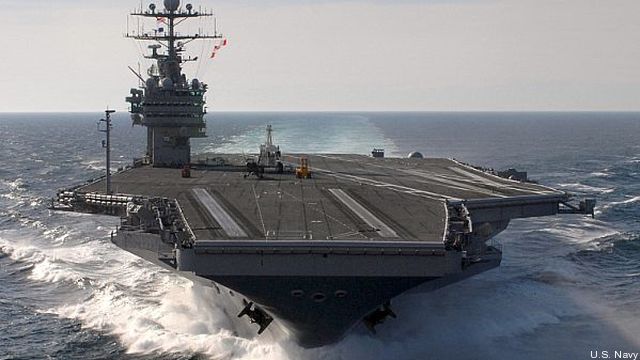
USS Harry Truman
Defense Secretary Ashton Carter‘s controversial Dec. 14 memo has sparked intense debate amongst the defense community. In that document, Carter directs the Navy to procure more fighter jets and truncate the Littoral Combat Ship program, among many other measures. Carter’s far-reaching proposal spawned an even more radical proposal by an esteemed naval analyst to shake up the US Navy’s force structure. Among the various suggestions that Norman Polmar made to Breaking Defense, the most controversial is the one to build more big-deck amphibious assault ships (LHDs and LHAs) in the place of nuclear-powered aircraft carriers (CVNs).
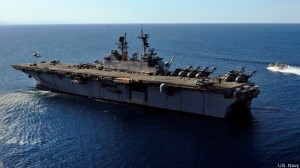
USS Bataan (LHD-5)
The Marines
One advantage of amphibians, Polmar contended, is that the Marines embarked onboard the amphib allows it to carry out various peacetime missions that the carrier can’t. While he didn’t delineate what these missions are, in the post-Cold War period, Marines have been deployed in various operations other than war (OOTW) like non-combatant evacuation and humanitarian assistance and disaster relief.
Is the LHD more capable than the carrier in handling such operations? Yes, but only to the extent that the amphibian, with some 1,900 Marines embarked, has a sizeable ground-troop complement that enables it to better handle operations short of war that necessitate a larger force ashore. In contrast, the carrier does not currently embark a battalion-sized ground force; indeed, the norm is for a small SEa-Air-Land (SEAL) special operations contingent to deploy together with it. However, a “light footprint” approach is more suited for many missions where there is no need for a substantial number of the 1,900 Marines onboard the LHD to go ashore.
As a matter of fact, for smaller-scale OOTW missions that may have a kinetic element, such as counter-terrorism and Tactical Recovery of Aircraft and Personnel, the carrier’s small naval special warfare component would probably suffice. Even if more ground forces are needed, say to facilitate a large-scale non-combatant evacuation from a besieged US embassy, Marine Fleet Anti-terrorist Security Teams (FASTs) could augment or even replace the SEALs. Being forward stationed near geostrategically sensitive areas – FASTs are based in Spain, Bahrain and Japan – these units could be deployed quickly to any carrier in the same locality.
That being said, there is a plan currently in the pipeline to make Marines a permanent fixture onboard surface ships again, including carriers. The driver is the need to bridge the “amphib gap” caused by the relative paucity of amphibious warfare vessels. While further details of this initiative, such as the number of Marines to be deployed on each ship, have yet to be worked out, initial signs are encouraging with various service bigwigs praising the concept.
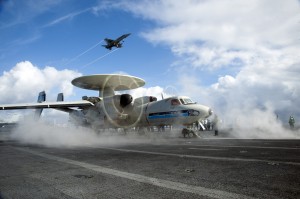
E-2C Hawkeye aboard the carrier USS Truman.
The Air Wing
Polmar also made the point that the carrier air wing is limited in capabilities, especially range. Yes, it seems weak in the face of some of the modern anti-access/area-denial (A2/AD) technologies belonging to America’s potential peer and near-peer adversaries. But has Polmar considered the fact that the amphib’s air wing is decidedly weaker? He did acknowledge the fact that the carrier is capable of sustained strike operations, which the LHD is not. However, Polmar did not mention the flat-top has organic airborne early warning (AEW) aircraft — E-2 Hawkeyes — and electronic warfare (EW) planes — EA-18G Growlers — two areas that the LHD’s air wing is flagrantly deficient in.
While such capabilities may seem like overkill against terrorists and insurgents, it’s worth noting that sophisticated anti-aircraft and anti-ship weapons are proliferating even to non-state actors like Hezbollah and the Islamic State. Indeed, “better to be safe than sorry” can never be truer than here, and having AEW and EW assets hedges against US forces being surprised. Furthermore, the carrier has a decent-sized complement of eight MH-60S Knighthawk utility helicopters with the vertical-lift capability required for a variety of OOTW missions. It is therefore rather surprising that Polmar said that the carrier can’t carry out as well many peacetime missions as the LHD.
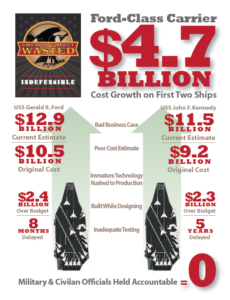
Graphic courtesy of the office of Sen. McCain
The Numbers Game
Polmar, like many other critics of the large-deck carrier, maintained that it’d be better to have more light flat-tops rather than one heavy one. He even went as far as to imply that four small-deck carriers are equivalent to a big-deck one. When Polmar cited $3 billion being needed to build an amphib and $12-odd billion for a flat-top in general terms, he was arguably referring to the new America-class amphibious assault ship (LHA) and the upcoming Ford-class supercarrier.
Had Polmar been more meticulous about the actual unit cost of each platform, he would have realized that one Ford carrier is actually cheaper than three America LHAs. According to the US Government Accountability Office, USS America’s unit cost is $3.3 billion. On the other hand, the $12.9 billion needed for the upcoming USS Ford is not merely the unit cost, but also includes some $3.3 billion for detailed design/non-recurring engineering purposes, which is the one-off cost to research, develop, design and test a new product — something many critics of the Ford fail to consider.
While the unit cost of USS Ford is still a princely $9.6 billion, the unit cost of her sister ships is likely to go down as the Ford program matures. And doing the math based on the figure of $9.6 billion, building just three America amphibs would actually cost more than getting one Ford flat-top, and it’d be less bang for the buck at that, as shown earlier.
Last of all, Polmar failed to consider the fact that the more amphibious assault ships that the Navy acquires, the more surface ships needed to escort the amphibs. This is because each Amphibious Ready Group (ARG) centered on an LHA/LHD also consists of three or four Ticonderoga-class cruisers and Arleigh Burke-class destroyers. The presence of these ships is essential considering the minimal self-defense capabilities of the amphibians. Create three new ARGs and you need around 10 destroyers and cruisers to join them — but the US Navy is already facing a numbers crunch with regard to its surface combatants.
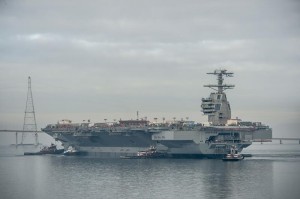
The new carrier USS Ford is afloat but still unfinished.
The Case For Carriers
All in all, Polmar’s argument that amphibious assault ships should replace supercarriers in the United States Navy is contentious. His contentions that amphibs are a better option for various peacetime missions and that one Ford carrier can get you four America LHAs do not hold water. In the same article, Polmar also posed the question: “Ask a [theater] combatant commander where he’d rather have one big carrier or four [LHA/LHDs]…?” His own implied answer is the latter. While it may seem overkill to send a supercarrier to handle adversaries like a bunch of ragtag irregulars, the reality on the ground is that the senior commander is likely to opt for the carrier over three or four amphibians, because of the flat-top’s overall superior capabilities.
All that being said, the argument Polmar makes is not entirely novel. The small-versus-large carrier question has always been part of the overall debate about the ship’s utility since the end of World War Two. In fact, the debate is unlikely to subside any time soon considering the emergence of A2/AD threats that could seriously undermine the viability of the carrier.
Is the American supercarrier untenable in a conflict with a peer adversary? Would it go the way of the battleship one day? These are no clear answers to such questions that are currently fuelling the debate. What is certain though is that it would take the crucible of combat for them to be adequately addressed. With many thousands of lives at stake surrounding such issues, hopefully, they will never be raised in real life.
Ben Ho Wan Beng is a Senior Analyst with the Military Studies Programme at Singapore’s S. Rajaratnam School of International Studies and he received his master’s degree in strategic studies from the same institution. Naval affairs is Ben’s main research interest, and his works in this area have been published in The Diplomat, War Is Boring, as well as the Center for International Maritime Security’s NextWar blog. He can be reached at iswbho@ntu.edu.sg.
Subscribe to our newsletter
Promotions, new products and sales. Directly to your inbox.
